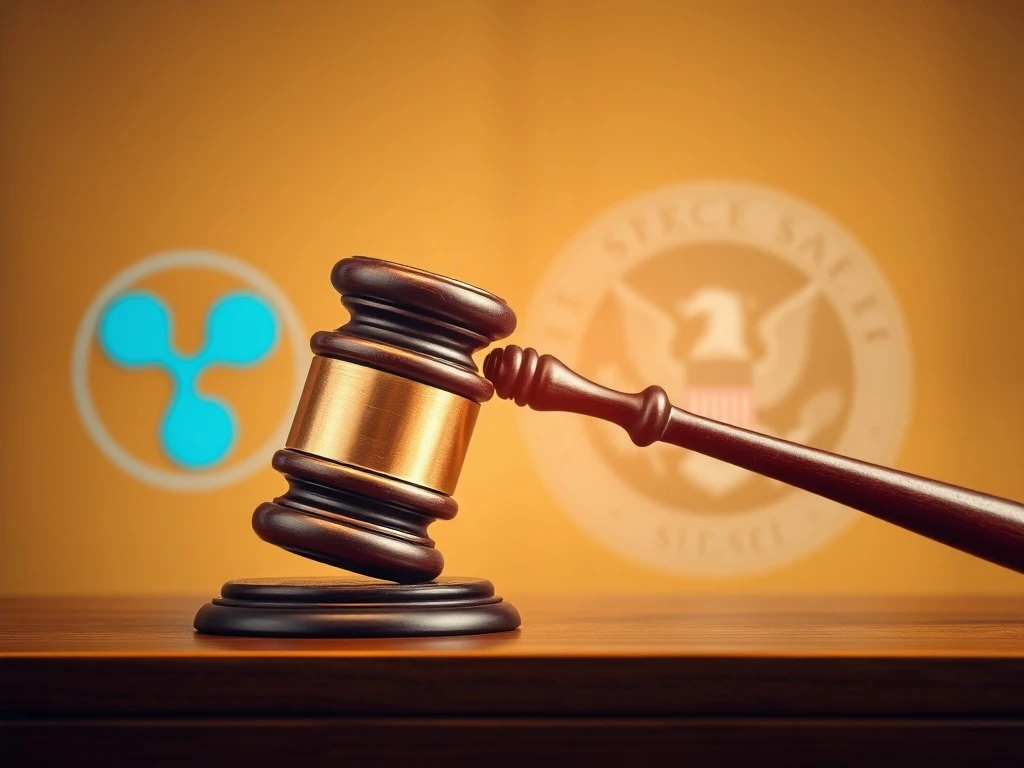Breaking: US Judge Delivers Crushing Blow to Ripple, SEC $125M Penalty Reduction Bid

The cryptocurrency world is buzzing with the latest development in the long-running Ripple SEC lawsuit. A recent ruling by a US district court judge has sent clear signals about the ongoing legal battles in the digital asset space, impacting the future of crypto regulation.
Understanding the Judge’s Stance on the Ripple SEC Lawsuit
Judge Analisa Torres of the US District Court for the Southern District of New York recently denied a joint motion from the US Securities and Exchange Commission (SEC) and Ripple. This motion sought an indicative ruling to reduce a $125 million civil penalty and reverse an order classifying primary sales of XRP to institutional investors as securities transactions under Article 5 of the Securities Act.
An indicative ruling is a procedural mechanism allowing lower courts to issue orders for a case pending review in a higher appellate court, subject to the higher court’s approval. However, Judge Torres firmly stated that the court would not undo its earlier rulings. She emphasized that these decisions, including the $125 million penalty, were consistent with federal securities laws passed by Congress. Her reasoning was direct: the court found that “Ripple’s willingness to push the boundaries of the [Summary Judgment] Order evinces a likelihood that it will eventually, if it has not already, cross the line.” This strong stance highlights the court’s commitment to its previous judgments and its view on Ripple’s past conduct.
The Enduring $125 Million SEC Penalty: Why the Court Upheld It
Despite claims from both parties that reducing the civil penalty by sixty percent and vacating the permanent injunction was in the public interest, Judge Torres disagreed. She asserted that the parties could only achieve such changes through the congressionally stipulated appeals process, not by directly petitioning the lower court to reverse its own orders. The court’s decision underscores the procedural integrity of the legal system, ensuring that established rulings are challenged through proper channels. The significant SEC penalty remains in place, serving as a reminder of the court’s earlier findings regarding Ripple’s institutional sales of XRP.
Implications for the XRP Lawsuit and Future Crypto Regulation
The denial of this joint motion has significant implications not just for the parties involved but for the broader landscape of crypto regulation. It reinforces the judiciary’s role in interpreting and enforcing existing securities laws within the evolving digital asset market. While the core of the XRP lawsuit concerning secondary sales of XRP was a victory for Ripple, this recent ruling on the penalty reminds the industry that regulatory scrutiny persists, especially concerning institutional offerings. This ongoing legal saga provides valuable precedents for how digital assets might be classified and regulated moving forward. It emphasizes the need for clarity and adherence to legal frameworks, even as the industry innovates.
The Winding Down of the Historic Legal Battle: What’s Next for Ripple?
Despite this recent setback regarding the penalty, the larger legal battle between the SEC and Ripple is indeed winding down. Ripple CEO Brad Garlinghouse announced on March 19 that the SEC had dropped its appeal against the company, hailing it as a “resounding victory” for Ripple and the crypto industry. As part of this wind-down, both parties had filed a motion to release the $125 million held in escrow for monetary penalties. Their proposal suggested that $50 million of the escrow balance would go to the SEC as a 60% discounted penalty, with the remaining $75 million returned to Ripple, pending court approval. However, Judge Torres’s recent ruling casts doubt on the immediate realization of this proposed discount. The crypto community continues to monitor the case closely, understanding that its outcome shapes the future of digital asset operations and compliance. The saga with Judge Analisa Torres continues to unfold, even as the main lawsuit concludes.
Conclusion: A Landmark Ruling for Crypto Compliance
The recent denial of the joint request to reduce the $125 million penalty marks another critical moment in the Ripple-SEC legal saga. While the broader lawsuit appears to be concluding with positive news for Ripple regarding the SEC’s dropped appeal, this ruling highlights the judiciary’s steadfast approach to enforcing existing securities laws. It serves as a potent reminder that despite shifts in regulatory focus, the courts will uphold their previous decisions unless challenged through the proper appellate channels. This case continues to be a crucial benchmark for the future of crypto regulation and how digital assets navigate the complex legal landscape, emphasizing the enduring need for compliance and clear legal frameworks.









